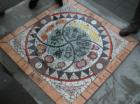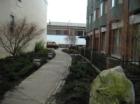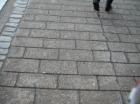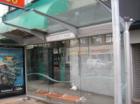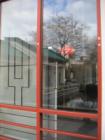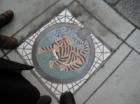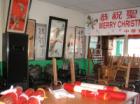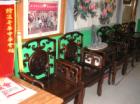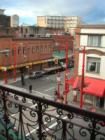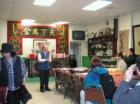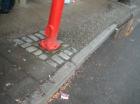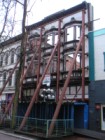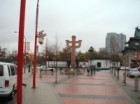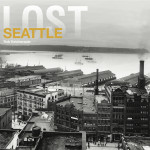In depth look at the streets and buildings of 'ethnic enclaves' in Vancouver.
In January of 2004 I had the good fortune to accompany a group of graduate students from UW and UBC, as well as community leaders from Seattle's Chinatown/International District on a trip to Vancouver's Chinatown. We were graciously hosted by a several community leaders in Vancouver and joined by Vancouver city staff.
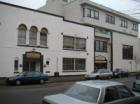
Japanese Hall
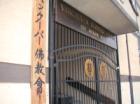
Buddhist Temple
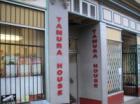
Tamura House
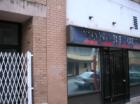
Tonari Gumi
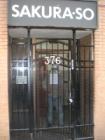
Sakuraso
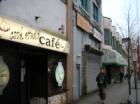
Hoko Sushi
Before joining the students at UBC for a presentation on findings of Seattle's Chinatown, I swung by the remnants of Vancouver's Japantown.
Few people realize that there is - or was - a Japantown in Vancouver, BC. Japanese Canadians were sent to camps as in the USA during World War Two. In the camps, they hung together by forming neighborhood associations ("tonari gumi"), a social structure common in towns across Japan. After the war, the Japanese Canadians had nothing left in Vancouver except their Japanese Hall and Language School building. As they spread throughout the Vancouver metropolitan region, the Tonari Gumi remained an important unifying force, and still exists today.
A tenuous grasp was restored, but in today's Oppenheimer neighborhood very few signs can be seen of the past of Japantown. On Alexander and Dunlevy, the Japanese Hall and Language School sits where it has since the 1920s. The surprising fortitude of the Japanese presence here is made clear by the 2000 expansion. On Powell and Dunlevy, the massive Japanese Buddhist Temple looks down on Oppenheimer Park.
Recently restored as low-income housing, the Tamura House was built by Mr. Tamura, who was responsible for establishing trade between Canada and Japan. Originally it was a hotel and his company's offices. It sits on Powell across Oppenheimer Park from the temple, at the intersection which served as the heart of Japantown.
A couple of store fronts down is the derelict former offices for Tonari Gumi. It's now located on Broadway. Three or four storefronts for Japanese businesses abut Tonari Gumi, but I wondered how much longer these would last.
Despite their still fading presence, the Japanese community celebrate a spring festival here in conjunction with the spring festival and lunar new year in Chinatown. The Chinatown groups are reaching out to their neighbors, and plan to possibly extend part of the parade to Japantown in 2005.
Walking through the dicey blocks surrounding Oppenheimer park, I couldn't help but think how lucky Seattle is. There are few cities in North America that can boast to have a Japantown. Only 4 or 5 can say it with a straight face. But not only is there still a Japanese presence in the old Japantown and into Chinatown, but the historic structures remain. Seattle's International District can be marketed as containing an active, historic Chinatown neighborhood, and a flowering Japantown as well.
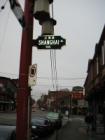
Chinatown street sign
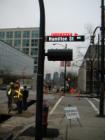
English side of Silk Road
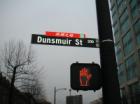
Normal sign on Silk Road
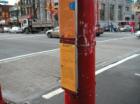
Placard on light post
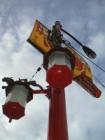
Chinatown banners
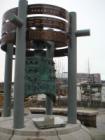
Han Bell and signs
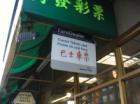
Ad hoc bilingual sign
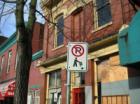
Canadian Loading
There are several types of signage around Vancouver's Chinatown.
On every intersection corner, street signs feature phonetic Chinese renderings of the English street names. The street signs differ in shape and color from others around Vancouver. They have a smaller, old font for English text. Corners are cut out, and the background color is black.
Along Pender from the downtown library, street signs have an additional red section on top with "Silk Road" on one side, equivalent text in Chinese on the other, and a blue pedestrian symbol. This is the first pedestrian route to be created downtown to point out connections between neighborhoods to tourists.
The next goes from Gastown to Yaletown, passing the library as well. Perhaps there is a sign up by the library that explains that the Silk Road links to and through Chinatown, because personally I didn't get it. When I saw the Chinese text I thought I was already in Chinatown.
On light poles along the Silk Road, a series of placards in English and Chinese explain the history of the neighborhood.
A series of banners also indicate the Silk Road route. Off the Silk Road, banners proudly proclaim that this is Chinatown, and indicate when the next major festival is.
Additionally, at the end of Shanghai Alley a set of ten large signs with lengthier text further explains significant aspects of the neighborhood, as well as connections with its Chinese sister city.
Obviously a variety of signs have been created by businesses. We were told of a recent initiative to add English names to product descriptions to be more receptive to the growing customer base that does not read Chinese. This includes Canadian-born Chinese, but more significantly the immense condo towers springing up around the western edges of the neighborhood. On a related note, I found several English signs that had had Chinese added to them.
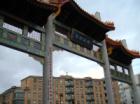
Chinatown Millennium Gate
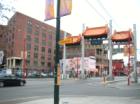
Chinatown Millennium Gate
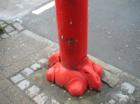
Base of old street lamp
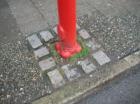
Base of old ped lamp
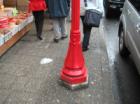
Base of another old lamp
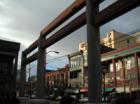
Gate at Chinatown Center
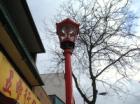
New lamp
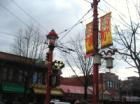
New and old lamps
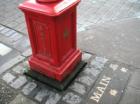
New ped base
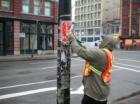
Bill Removal
Visitors coming from downtown are greeted to Chinatown by the massive Chinatown Millennium Gate. The gate straddles the street with four posts, reflecting traditional design which most North American cities have been unable to incorporate. A bike lane and general purpose lane go through one side, two general purpose lanes in the middle, and a bus lane through the other side. The colorful design was done using printed appliqués, in order to make renewal cheaper in the future.
This was a lesson hard-learned in the community. The gate at Chinatown Center is not intended as a brutalist interpretation of Chinese gates. Its intricate covering, designed and built in China, was taken down recently because it has become so aged and worn. The community is not sure what to do yet; it will take over C$100,000 to send it to China to have it fixed by artisans.
One of the most obvious indicators that you've arrived in Chinatown is the red poles.
It started with the high overhead streetlamps, which the neighborhood repainted from the rusty black color found throughout the rest of the city. On these they added pedestrian-level lights with gold dragons on top. It's common practice for Chinatowns to buy antique-style lamps and have them painted red. The gold dragons are a nice touch that differentiates Vancouver from other cities.
New lamps were added recently after a quick design process. The neighborhood received a joint federal/provincial/municipal grant to install the lamps, but because of budgetary reasons they only had 30 days to take the project from concept to completion. The lamps feature a gold maple leaf on the base, along with "Chinatown" in gold Chinese letters. Brass lettering in English and Chinese indicate streets at corner. The neighborhood hopes to leverage the cooperative synergy that the process brought about among many different groups.
Interestingly, poles in Chinatown have few bills posted on them. In a nearby neighborhood I found a city employee removing a flier taped to it with a multi-use tool. In Chinatown, I saw a few fliers for several-month old events, but not the accumulation of remnants obvious in my photograph. Perhaps they are more diligent about cleaning or painting. Or, it could be that posterers seldom venture into the area, as with Seattle's Chinatown.
Chinatown sports the same utility poles found throughout downtown Vancouver. Unlike any other city that I've seen, they still run down alleys, and actually resemble gates themselves. Seattle's utility poles have small numbers nailed to them, but Vancouver's poles were done sloppily with paint. I couldn't decide it if added to the gritty charm of alleys, or if it made discarded spaces seem that much less loved.
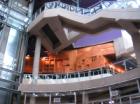
International Village
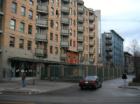
First Nations Youth Housing
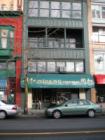
Ming's Cookware
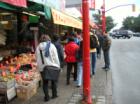
Vegetables and Herbs
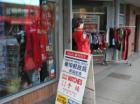
Dress Shop
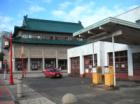
Gas and Cultural Center
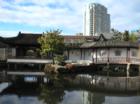
Garden with new skyline
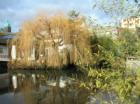
Garden with old skyline
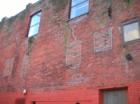
Alley openings
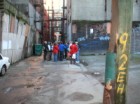
Alley
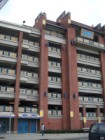
Mall with parking
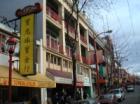
Balconies
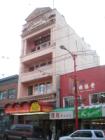
Chin Wing Chun
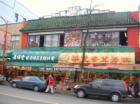
Yueh Wah
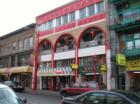
Red Arches
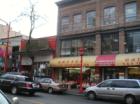
False Roof
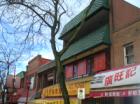
Ng Fung
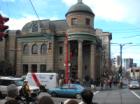
Carnegie Library
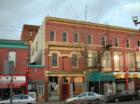
Iterative Building
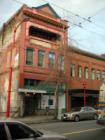
Cheng Wing Yeong Tong
Chinatown has a host of interesting buildings.
Most recent is International Village, a shopping mall adjacent to the Millennium Gate on Pender. Built largely in response to the Asian malls popping up in suburbs like Richmond and Burnaby, International Village was intended as an upscale mall. It is also anchored by a multiplex movie theater. Unfortunately it just didn't work. Perhaps because of the proximity of downtown Vancouver's multiple malls, International Village's upscale shops didn't attract the expected visitors. Instead, they've been replaced with Asian furnishings and other mid-level stores. The neighborhood is trying to think outside of the box on how to reuse this space.
Across from International Village is the First Nations Youth Housing. This building was designed by a Chinese American architect, and sports a very interesting entryway.
The historic structures in Chinatown are boisterous and provocative. Many of them are built on narrow, deep plots. It was common to build three or four floors on the street, then six or eight stories along the alleyway. Alleys in Vancouver are quite a bit wider than Seattle, for example. They're wide enough to park a car in and still drive another by. Door and windows are boarded and bricked over now, but in the first half of the 1900s, they were bustling. Tellingly, I saw police advise loitering people in alcove doorways to move along. In Seattle we've begun systematically installing gates to remove these sanctuaries from street sight-lines.
In Vancouver's Chinatown I kept my eyes open for stores lacking in Seattle. First to catch my eye was a cookware shop, Ming's, which has other branches in the city as well. I also found a few "Oriental Art Supply" shops. Back in Seattle I found similarly signed stores that actually sold works of art, not supplies for making art. I believe the Vancouver stores actually sell ink and other art supplies, though I didn't go in to verify. The difference between vegetable/herb stands in each city is significant enough to include them. In the core of Seattle's Chinatown, herb stores are inside. East of the freeway, vegetable stores spill out across big sidewalks, but only one or two are part of the walking tours of the historic neighborhood west of the freeway. Vancouver's herb stores and vegetable stands spill out of small storefronts with open fronts, challenging you to even try to ignore them. Dried fish and contorted vegetables draw laughs and bewildered looks from tourists. It's a great low-pressure introduction to another culture.
The spectacular growth of downtown Vancouver is beginning to encroach on Chinatown. When it was built, the Dr. Sun Yat Sen Memorial Garden had just a few buildings barely peaking over its walls. Now condominium towers are reflected in its still ponds, and more are soon to follow. The neighborhood's leaders are embracing the change, giving guided tours to new residents so that they will become a new customer base for businesses and restaurants.
Across from the side entrance to the Cultural Center and the garden lies an abandoned gas station. It's nice to know that Seattle doesn't have the only Chinatown with an abandoned gas station. Perhaps the Rocket station is barely within our boundaries, and we have two [Rocket was renovated and opened as a restaurant in 2005]. Anyways, Vancouver's station remains because they were unable to work something out with its owner before he passed away. Now his descendants are trying to settle ownership, and the neighborhood waits patiently for something to happen.
